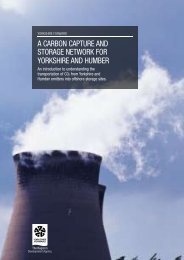Final report for One North East And NEPIC 21/12/10 - The Carbon ...
Final report for One North East And NEPIC 21/12/10 - The Carbon ...
Final report for One North East And NEPIC 21/12/10 - The Carbon ...
Create successful ePaper yourself
Turn your PDF publications into a flip-book with our unique Google optimized e-Paper software.
<strong>The</strong> case <strong>for</strong> a Tees CCS network<strong>Final</strong> Report6 Project structuring and ownership<strong>The</strong> previous two chapters highlighted the nature of commercial risks, how these can bemanaged and how these play out in terms of financing challenges <strong>for</strong> a CCS network inthe Tees Valley. Finding the right balance between risk, reward (revenues) and thesources of finance will be critical to creating a commercially viable project proposition <strong>for</strong>the CCS network. This may be achieved through appropriate structuring of the project withrespect to its promotion, ownership, financing, design, construction and operation.This section sets out how the project could be structured in different ways to take accountof the risks and sources of finance in order that an optimal solution may be delivered. Anoptimal solution is one where all parties are effectively insulated against the risk of failureof one another, and where the risks (and rewards) are effectively distributed to thoseparties most able to accept them (or <strong>for</strong> rewards: are merited on the basis of risk appetite).However, it should also be noted that in reality, the most optimal solution may not bepossible due to prevailing policies of key stakeholders at the current time.Options <strong>for</strong> project structuringFigure 16 highlighted the number of actors and agreements that need to be in place, andby inference the complexity involved and coordination needed to get a CCS network offthe ground. Finding an appropriate structure <strong>for</strong> the project will help to manage,consolidate and reduce counter-party risk between the different actors involved, andthere<strong>for</strong>e significantly influence the ability of the project to attract private finance, and thecost of that funding.Appropriate structures can consolidate and simplify relationships between parties, reducethe number of entities involved and the number of counter-party agreements needed, andallow <strong>for</strong> common commercial linkages between entities to evolve. To illustrate this, wecan envisage two scenarios which cover options at each extreme of a spectrum available<strong>for</strong> project structuring:1. <strong>The</strong> laissez-faire model. At one end of the spectrum, the laissez-faire approachrequires each entity to operate independently with an absence of centralisedcoordination (i.e. no promoter). <strong>The</strong> web of agreements and contracts would needto evolve organically, financing <strong>for</strong> each component would need to be obtainedindependently, and the design, construction and operation of pipeline networkwould need to evolve with limited <strong>for</strong>esight, with each operator taking onresponsibility <strong>for</strong> their own segment to the point where another operator takes onthe responsibility. This is a very challenging prospect indeed.2. <strong>The</strong> centrally planned model. At the opposite extreme of the spectrum, acentrally planned approach would involve a single entity stepping in and takingresponsibility <strong>for</strong> to promote, design, build, finance, and operate the onshorenetwork, the offshore pipeline, and the storage/EOR (a design-build-financeoperate- DBFO - model). An extreme variant could also see the same entitytaking on responsibility <strong>for</strong> investing in and operating capture plant at connectinginstallations.<strong>The</strong> laissez-faire approach probably corresponds more closely to the current situation inthe Tees Valley. It relies on the organic development of the system amongst interested55







